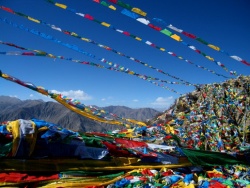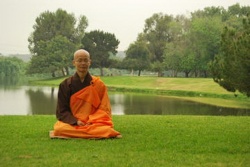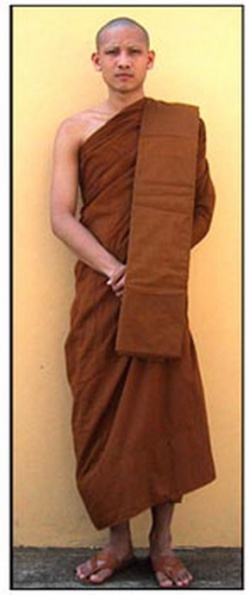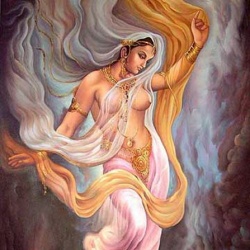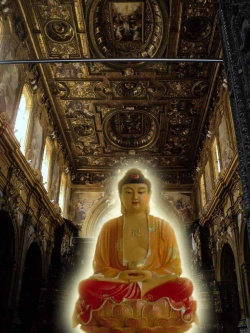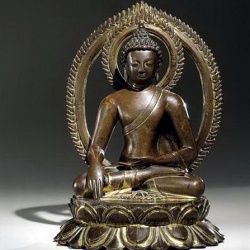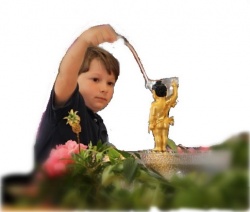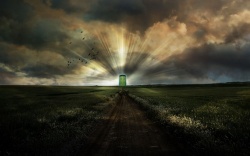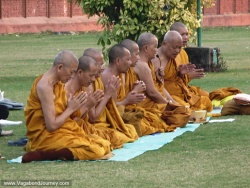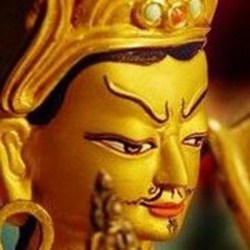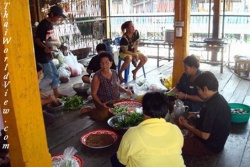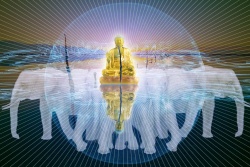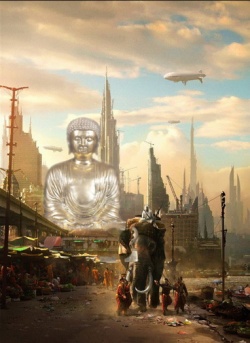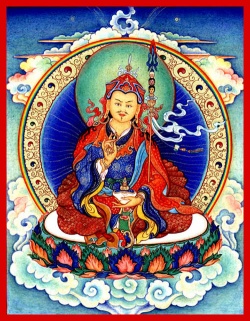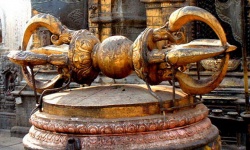Terma
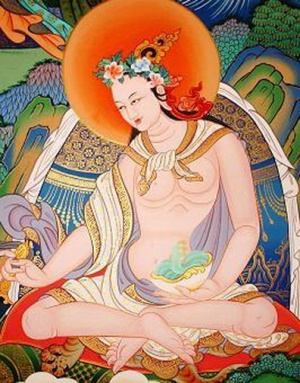
Categories of Terma
The golden image at the centre is a kutsab known as Ngödrup Palbar and was discovered from Tsiké Norbu Punsum.[3]Termas are divided into two categories, according to the manner in which they were concealed and discovered:
- earth termas (Tib. ས་གཏེར་, sa ter), which employ physical objects, and
- mind termas (Tib. དགོངས་གཏེར་, gong ter), discovered within the mindstream of the tertön.
In the discovery of earth termas, earthly materials such as symbolic script written on yellow scroll are used to awaken the terma in the mind of the tertön. In the discovery of mind termas, no external earthly objects are relied on.
In many instances of mind terma, seeing or hearing symbolic words or sounds in visions causes the discovery of the terma.
- Another type of terma in the Nyingma tradition are pure vision (Tib. དག་སྣང་, dak nang) teachings.
- Sogyal Rinpoche writes:
- ‘Terchö’ literature can be in three parts: Lama, Dzogchen & Tukjé Chenpo (Tib. བླ་རྫོགས་ཐུགས་གསུམ་, la dzog tuk sum), i.e.
- teachings on Dzogchen, and
- sadhana cycle on Avalokiteshvara (Tib. Tukjé Chenpo).
The Terma Tradition
[[Image:3rddodrupchen.jpg|thumb|Dodrupchen Jikmé Tenpé Nyima wrote a treatise on the terma tradition)] Tulku Thondup explains the Terma tradition of Tibet as follows:
- In a number of spiritual traditions of the world there are many instances of the discovery of teachings and objects through mystical power.
Similarly, in various traditions and lineages of Buddhism, in India as well as Tibet, numerous mystical discoveries of teachings and objects have taken place.
- In the Nyingma school of Tibetan Buddhism, the tradition of concealment and revelation of teachings and materials of religious value through the mystical power of enlightened beings is most prevalent by far.
This tradition of mystical discovery is known in Tibetan as Ter ('Treasures'), Terma ('Treasured Ones'), or Terchö ('Dharma Treasures' or 'Treasured Teachings').[5]
- The main source of the Terma tradition of the Nyingma school is Guru Padmasambhava. [6]
- While transmitting esoteric teachings to his realized disciples in Tibet, Guru Padmasambhava concealed many teachings with the blessings of his enlightened mind stream in the nature of the intrinsic awareness of the minds of his disciples through the power of “mind-mandated transmission” (Tib. གཏད་རྒྱ་, Wyl. gtad rgya); thereby the master and disciple became united as one in the teachings and realization.
Here, the master has concealed the teachings and blessings, the esoteric attainments, as ter in the pure nature of the minds of his disciples through his enlightened power, and he has made aspirations that the ter may be discovered for the sake of beings when the appropriate time comes.[7]
Chagdud Tulku Rinpoche writes:
- In propagating the Buddha’s teachings amid the shamanistic society that dominated Tibet at that time, Padmasambhava saw clearly that some teachings would have to wait for a more appropriate time to take root.
He concealed them until certain great practitioners…would reveal them and bring them to fruition.[8]
Notes
- ↑ Tulku Thondup Rinpoche, Masters of Meditation and Miracles, edited by Harold Talbott (Boston: Shambhala, 1996).
- ↑ That's why translator B. Allan Wallace refers to termas as 'spiritual time-capsules'.
- ↑ Tulku Thondup Rinpoche, Hidden Teachings of Tibet, central pictures.
- ↑ Sogyal Rinpoche, Dzogchen and Padmasambhava, page 74.
- ↑ Tulku Thondup, Enlightened Journey: Buddhist Practice as Daily Life, pages 93-94.
- ↑ Ibid, page 95.
- ↑ Ibid, page 96.
- ↑ Chagdud Tulku, Lord of the Dance (Junction City: Padma Publishing, 1992), page 11.
Further Reading
- Andreas Doctor, Tibetan Treasure Literature: Revelation, Tradition and Accomplishment in Visionary Buddhism (Ithaca: Snow Lion, 2005).
- Dudjom Rinpoche, The Nyingma School of Tibetan Buddhism (Boston: Wisdom, revised edition 2002).
- Janet B. Gyatso, 'Drawn from the Tibetan Treasury: The gTer ma Literature' in Cabezón and Jackson, ed., Tibetan Literature: Studies in Genre (Ithaca: Snow Lion, 1996).
- Michael Aris, Hidden Treasures and Secret Lives, Motilal Banarsidass, 1988.
- Ringu Tulku, The Ri-me Philosophy of Jamgön Kongtrul the Great (Boston & London: Shambhala Publications, 2006), pages 117-121 & 159-160.
- Thinley Norbu, The Small Golden Key (Shambhala Publications, 1999), ‘4. Nyingmapa Kama and Terma'.
- Tulku Thondup, Hidden Teachings of Tibet: An Explanation of the Terma Tradition of the Nyingma School of Buddhism (London & Boston: Wisdom Publications, 1986, reprint edition 1997).
External Links
A collection of translations of termas on Lotsawa House
Source
Terma (Tibetan: གཏེར་མ་, Wylie: gter ma; "hidden treasure") are key Tibetan Buddhist and Bön teachings, which the tradition holds were originally esoterically hidden by various adepts such as Padmasambhava and his consorts in the 8th century for future discovery at auspicious times by other adepts, known as tertöns.
As such, they represent a tradition of continuing revelation in Buddhism. The majority of terma teachings are tantric in nature, although there are notable exceptions.
Terma tradition
Tradition holds that terma may be a physical object such as a text or ritual implement that is buried in the ground (or earth), hidden in a rock or crystal, secreted in a herb, or a tree, hidden in a lake (or water), or hidden in the sky (space).
Though a literal understanding of terma is "hidden treasure", and sometimes objects are hidden away, the teachings associated should be understood as being 'concealed within the mind of the guru',
that is, the true place of concealment is in the terton's mindstream.
If the concealed or encoded teaching or object is a text, it is often written in dakini script: a non-human type of code or writing.
Fremantle (2001: p. 19) states:
- ...termas are not always made public right away. The conditions may not be right; people may not yet be ready for them; and further instructions may need to be revealed to clarify their meaning.
Often, the tertön himself has to practice them for many years.
In this way, one may see the tradition of terma and terton as analogous to that of inspiration and providing a legitimate cultural forum to ensure continuation of tantric tradition, and ensuring Vajrayana Buddhism's and Bön's continued relevancy in an evolving world.
The terma tradition is particularly prevalent in, and significant to, the Nyingma lineage.
Two of the most famous tertön in the 20th century, Dudjom Rinpoche and Dilgo Khyentse Rinpoche, were of the Nyingma school.
Tertön are also prevalent in Bön and a few tertön have been Kagyu.
Padmasambhava and his principal consorts and disciples secreted away and hid scriptures, ritual objects and relics etc., to secure and protect Buddhism during the time of decline under King Langdarma.
Some of these terma have been rediscovered and special terma lineages established throughout Tibet as a result.
Out of this activity developed, especially within the Nyingma tradition, two ways of dharma transmission: The so called "long oral transmission" from teacher to student in unbroken disciplic lineages and the "short transmission" of terma.
The foremost revealers of these terma were the Five Terton Kings and the Eight Lingpas.
In the 19th century some of the most famous were the Khen Kong Chok Sum referring to Jamyang Khyentse, Jamgon Kongtrul and Chokgyur Lingpa.
Terma have been relayed by nāga and the dakini, of the underworld and the heavens respectively, and have also been hidden by teachers such as the great translator Longchenpa.
Antecedents and analogies in other traditions
The central Mahayana figure Nagarjuna rediscovered the last part of the "Prajnaparamita-Sutra in one hundred thousand verses" in the realm of nāga, where it had been kept since the time of Buddha Shakyamuni.
The terma tradition of rediscovering hidden teaching is not unique to Tibet.
It has antecedents in India and cultural resonances in Hindu Vaishnavism as well.
The Vaishnava saint Chaitanya is said to have rediscovered a fragment of the Brahma Samhita in a trance state of devotional ecstasy.
There is another occasion involving Chaitanya who deposited his divine love (prema) for great saint Narottama dasa Thakura in the river Padma in Bangladesh.
When Narottama turned twelve years of age, he collected this treasure after a revelation in a dream.
Types of terma
Fremantle (2001: p. 17) affirms that according to tradition:
- Termas are of two main kinds: earth treasures and intention treasures, or mind treasures.
A teaching concealed as an intention treasure appears directly within the mind of the tertön in the form of sounds or letters to fulfill the enlightened intention of Padmakara.
Earth treasures include not only texts, but also sacred images, ritual instruments, and medicinal substances, and are found in many places: temples, monuments, statues, mountains, rocks, trees, lakes, and even the sky.
In the case of texts, they are not, as one might imagine, ordinary books that can be read straightaway.
Occasionally, full-length texts are found, but they are usually fragmentary, sometimes consisting of only a word or two, and they are encoded in symbolic script, which may change mysteriously and often disappears completely once it has been transcribed.
They are simply the material supports that act as a trigger to help the tertön reach the subtle level of mind where the teaching has really been concealed.
It is the tertön who actually composes and writes down the resulting text, and so may be considered its author.
The earth-terma are physical objects — which may be either an actual text, or physical objects that trigger a recollection of the teaching.
The mind-terma are constituted by space and are placed via guru-transmission, or realizations achieved in meditation which connect the practitioner directly with the essential content of the teaching in one simultaneous experience.
Once this has occurred, the tertön holds the complete teaching in mind and is required by convention to transcribe the terma twice from memory (if of textual nature) in one uninterrupted session.
The transcriptions are then compared and if no discrepancy or inconsistency is evident, the terma is sealed as authentic.
The tertön is required to realise the essence of the terma prior to formal transmission.
In one sense, all terma may be considered as mind-terma as the teaching associated is always inserted in the mind of the practitioner, in other words the terma is always a direct mindstream transmission from the vidyadhara.
The terma may also be held in the mindstream of the tertön and realised in a future incarnation at a beneficent time.
A vision of a syllable or symbol may leaven the realisation of the latent terma in the mindstream of the tertön.
The process of hiding in the mindstream implies that the practitioner is to gain realisation in that life.
At the time of terma concealment, a prophecy is generally made concerning the circumstances in which the teaching will be re-accessed. Especially in the case of an earth-terma, this usually includes a description of locality, and may specify certain ritual tools or objects which are required to be present, and the identities of any assistants and consorts who are required to accompany or assist the tertön.
Though somewhat contentious, the kind of revealed teaching embodied in the terma system is based in solid Mahayana Buddhist traditions.
The example of Nagarjuna is often cited; the Prajnaparamita teachings are traditionally said to have been conferred on Nagarjuna by the King of the nāgas, who had been guarding them at the bottom of a lake.
Similarly, the Six Treatises of Asanga are considered to have been conferred on him by the Buddha Maitreya, whom he visited in Tushita heaven during a vision.
"Pure visions" are pure teachings received from the vision of deities and are not necessarily terma as they do not require mindstream transmission from a vidyadhara to the practitioner experiencing the pure vision.
The esoteric teachings resulting from pure vision are based on the tantras and are sometimes attributed as terma due to their merit.
Bön terma
A terma tradition also exists in the Bön religion.
Most Bön termas were hidden during the period of decline under King Trisong Deutsen, and rediscovered around the 11th century.
Teachings were hidden by masters such as Lishu Tagring and Drenpa Namkha, often inside Buddhist temples as in Samye and Lhodrak.
The Three Treasures of Everlasting Bon
For the Bonpo, the Gankyil denotes the three principal 'terma' (Tibetan) or "treasure cycles of Everlasting Bon,
the 'Northern Treasure' (Wylie: byang gter),
the 'Central Treasure' (Wylie: dbus gter), and
the 'Southern Treasure' (Wylie: lho gter).
The Northern Treasure is compiled from texts revealed in Zhangzhung and northern Tibet, the Southern Treasure from texts revealed in Bhutan and the southern area of Tibet, and the Central Treasure from texts revealed in central Tibet close to Samye Monastery.
A cavern of treasures
'A Cavern of Treasures' (Tibetan: མཛོད་ཕུག, Wylie: mdzod phug) is a terma uncovered by 'Shenchen Luga' (Tibetan: གཤེན་ཆེན་ཀླུ་དགའ, Wylie: gshen chen klu dga') in the early eleventh century. Martin (n.d.: p. 21) identifies the importance of this scripture for studies of the Zhang-Zhung language:
- "For students of Tibetan culture in general, the mDzod phug is one of the most intriguing of all Bon scriptures, since it is the only lengthy bilingual work in Zhang-zhung and Tibetan (some of the shorter but still significant sources for Zhang-zhung are signalled in Orofino 1990."
Prominent terma cycles
One of the most famous terma known throughout the world is Bardo Thodol (Tibetan: བར་དོ་ཐོས་གྲོལ་, Wylie: bar do thos grol; "Liberation by Hearing in the State of Bardo").
It is popularly (but incorrectly) known as the Tibetan Book of the Dead.
As a set of funerary texts and practices, it had a very specialized utility, and was revealed by Karma Lingpa, who also revealed the Zhitro teachings.
Among other famous terma cycles are:
- Longchen Nyingtig (Heart Essence of Longchenpa) Another well-known Dzogchen cycle of texts, revealed to tertön Jigme Lingpa in the 18th century.
- Rinchen Terdzod (Precious Treasures) Jamyang Khyentse Wangpo, Jamgon Kongtrul Lodro Thaye, and Chogyur Dechen Lingpa assembled thousands of Terma treasure texts from the Nyingma tradition all across Tibet, creating the 108 volumes of the Rinchen Terdzod.
- Jangter (Wylie: Byang gTer, Northern Treatures) revealed by Rigdzin Godem. Features the prominent sub-cycle, the Konchok Chidu revealed by the terton Jatson Nyingpo and widely practiced in Kagyu lineages as well.
- Chokling Tersar (New Treasures) revealed by Chogyur Dechen Lingpa.
Minor terma cycles
- Nam Cho (Space Treasures) transmissions and empowerments are considered the heart transmission specific to the Palyul Lineage.
These teachings were revealed as terma to the 17th century Terton, Migyur Dorje, and were expanded upon by his root teacher, Karma Chagme Rinpoche (the great Kagyu master).
- Dudjom Tersar encompasses all the terma revelations of Dudjom Lingpa and Dudjom Rinpoche.
{{R}
